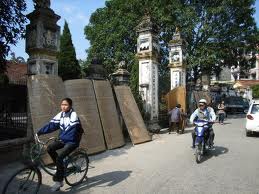At about 30km from Hanoi capital, Cu Đa village (Cu Khe commune, Thanh Oai district, Ha Tay province) has well-kept specifications of ancient Viet.
| In any hamlets or any lanes. There are vaulted gates. Village roads are laid with slanting bricks. On road-sides, there are old houses in ancient Viet styles, villas in French styles and newly-built ones. Houses are numbered and it might be the one and only village in Vietnam where houses got numbered. There are now round two hundred old houses both in Viet and French styles, of these, 60 remain almost unchanged. Houses in Cu Đa are low and deep in length, so they are always cool in summer and warm in winter. Architecture is specified in Nguyễn feudalist dynasty, nearly made of wood. On beams, pillars, there are delicate sculptures. In the middle of the houses, there are ancestral altars, panels and parallel scrolls.  The main village road is built along a riverside, every lane has a gate. This specific planning could be only seen in ancient Viet village where the economy relies on agriculture and trading. The most convenient position of the village is being close to the market and river (it’s next to Ha Đong town and Hanoi). The village pagoda is classified as national relics, it’s Linh Minh Tu and a stone column is inscribed “the pagoda was renovated in 1695”. There also remains relic of the village altar to worship “earth and heavens” or Xã Tắc, considered to be the most magnificent. There are also houses that were built in years from 1920 – 1940 (in new architectural styles). On a river bank, there’s a flag-pole built in 1929, a communal house of the village-council, a school. At one end of the village (entry road), there’s a low earthen hill named Đống Già , it’s thought to be a centuries-old tomb since the old Chinese colony. |
No comments:
Post a Comment